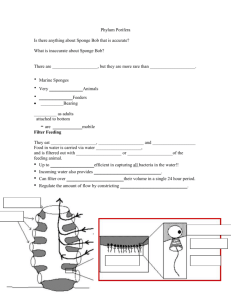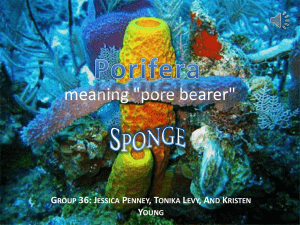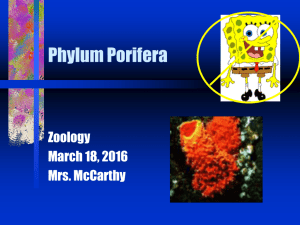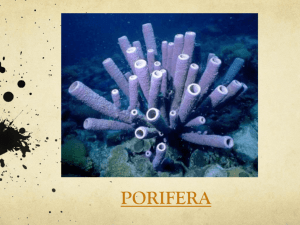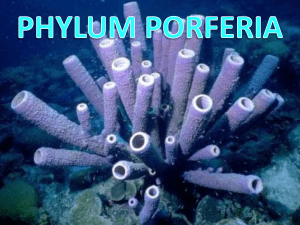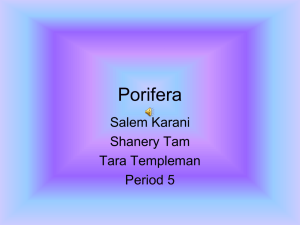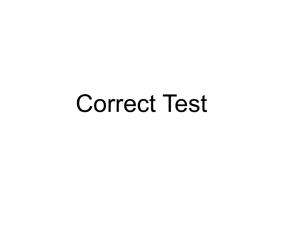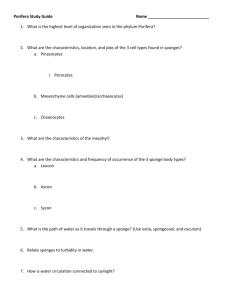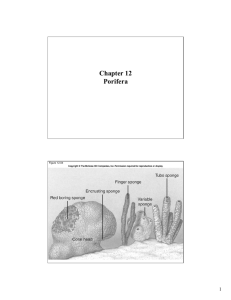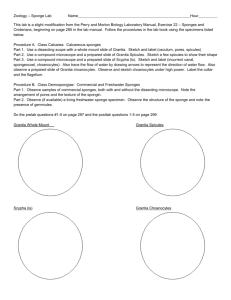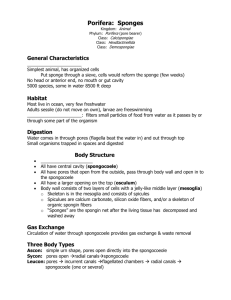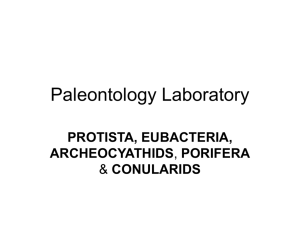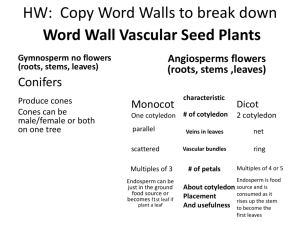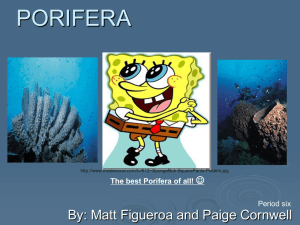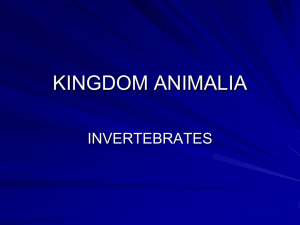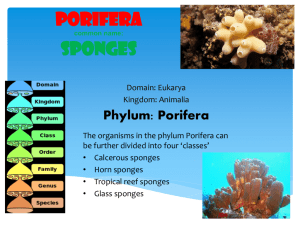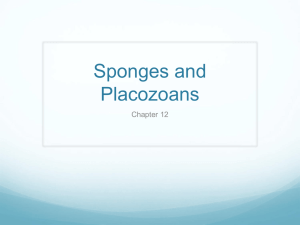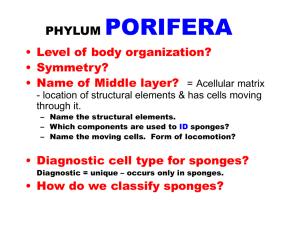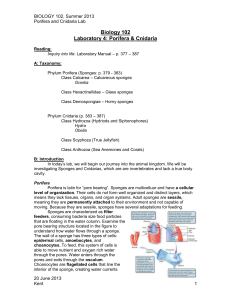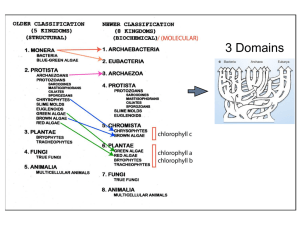Porifera Book Work
advertisement
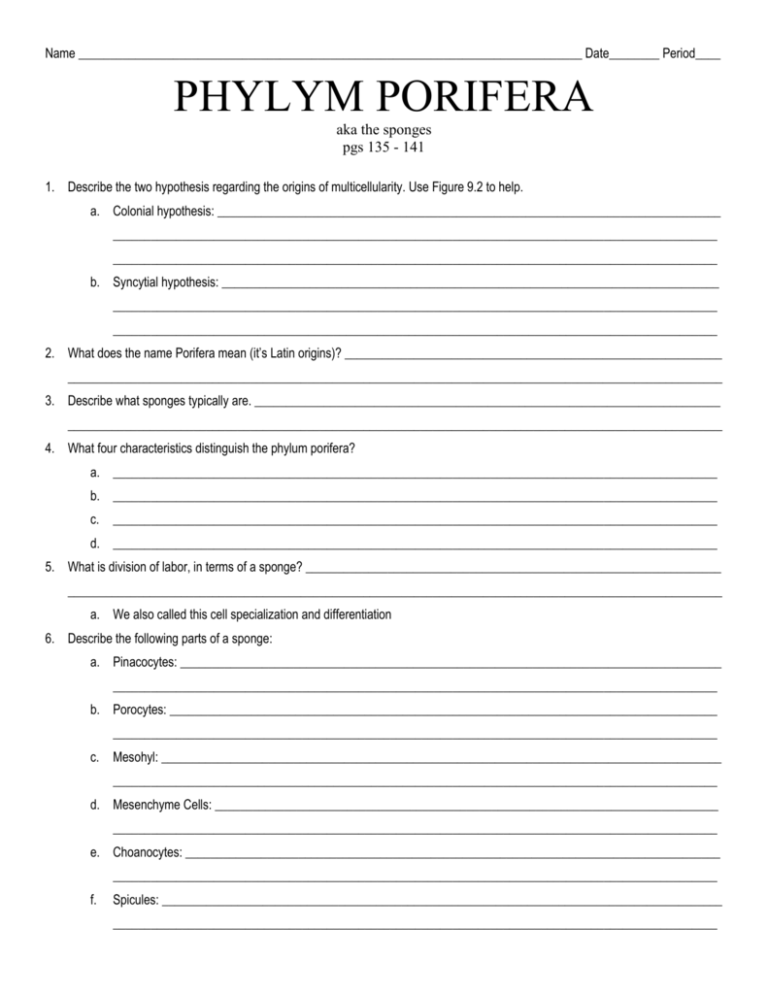
Name ________________________________________________________________________________ Date________ Period____ PHYLYM PORIFERA aka the sponges pgs 135 - 141 1. Describe the two hypothesis regarding the origins of multicellularity. Use Figure 9.2 to help. a. Colonial hypothesis: ________________________________________________________________________________ ________________________________________________________________________________________________ ________________________________________________________________________________________________ b. Syncytial hypothesis: _______________________________________________________________________________ ________________________________________________________________________________________________ ________________________________________________________________________________________________ 2. What does the name Porifera mean (it’s Latin origins)? ____________________________________________________________ ________________________________________________________________________________________________________ 3. Describe what sponges typically are. __________________________________________________________________________ ________________________________________________________________________________________________________ 4. What four characteristics distinguish the phylum porifera? a. ________________________________________________________________________________________________ b. ________________________________________________________________________________________________ c. ________________________________________________________________________________________________ d. ________________________________________________________________________________________________ 5. What is division of labor, in terms of a sponge? __________________________________________________________________ ________________________________________________________________________________________________________ a. We also called this cell specialization and differentiation 6. Describe the following parts of a sponge: a. Pinacocytes: ______________________________________________________________________________________ ________________________________________________________________________________________________ b. Porocytes: _______________________________________________________________________________________ ________________________________________________________________________________________________ c. Mesohyl: _________________________________________________________________________________________ ________________________________________________________________________________________________ d. Mesenchyme Cells: ________________________________________________________________________________ ________________________________________________________________________________________________ e. Choanocytes: _____________________________________________________________________________________ ________________________________________________________________________________________________ f. Spicules: _________________________________________________________________________________________ ________________________________________________________________________________________________ g. Spongin: _________________________________________________________________________________________ ________________________________________________________________________________________________ 7. There are 3 classes of the Phylum Porifera; these classifications are based on a sponges________________________________. a. Class Calcarea: _____________________ spicules; ____________________________ sponges b. Class Hexactinellida: _____________________ spicules; ____________________________ sponges c. Class Demospongiae: _____________________ spicules; ____________________________ sponges 8. What do sponges eat? _____________________________________________________________________________________ ________________________________________________________________________________________________________ 9. Describe how sponges transport nutrients and food. (How do they eat and get rid of wastes?) _____________________________ ________________________________________________________________________________________________________ ________________________________________________________________________________________________________ ________________________________________________________________________________________________________ ________________________________________________________________________________________________________ ________________________________________________________________________________________________________ ________________________________________________________________________________________________________ 10. Most sponges are monoecious. What does this mean? ____________________________________________________________ ________________________________________________________________________________________________________ 11. Are humans monoecious? Why or why not? ____________________________________________________________________ ________________________________________________________________________________________________________ ________________________________________________________________________________________________________ 12. Describe how some sponges reproduce sexually. ________________________________________________________________ ________________________________________________________________________________________________________ ________________________________________________________________________________________________________ ________________________________________________________________________________________________________ 13. Describe how some sponges reproduce asexually. _______________________________________________________________ ________________________________________________________________________________________________________ ________________________________________________________________________________________________________ ________________________________________________________________________________________________________ ________________________________________________________________________________________________________ Analysis Questions 14. Members of the Phylum Porifera are characterized by all of the following, except a. asymmetry or superficial radial symmetry b. pinacocytes c. mesenchyme cells d. cnidocytes 15. Skeletal elements found within the Porifera include a. Spicules b. Gemmules c. Sponging d. Mesoglea 16. In the sycon sponge body form, Choanocytes line the a. Spongocoel b. Gastrovascular cavity c. Radial canals d. Incurrent canals 17. Colonies are defined as “loose associations of independent cells.” Why are sponges considered to have surpassed that level of organization? (check your answer to #4) _______________________________________________________________________ ________________________________________________________________________________________________________ ________________________________________________________________________________________________________ ________________________________________________________________________________________________________ ________________________________________________________________________________________________________ ________________________________________________________________________________________________________ 18. Label the parts of the Simple Sponge 19. Label the parts of the __________________________________________. 20. What is this cell’s function? _________________________________________________________________________________ 21. How does the structure of this cell aid in its function? _____________________________________________________________ ________________________________________________________________________________________________________ ________________________________________________________________________________________________________ 22. Explain how food is moved from the outside of this cell to the place of digestion. ________________________________________ ________________________________________________________________________________________________________ ________________________________________________________________________________________________________

